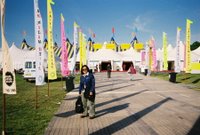 Pasadena, California, early 1960's the first Indos, De SOOS club
Pasadena, California, early 1960's the first Indos, De SOOS clubIt is estimated that around 60,000 Indos (Indisch or Dutch-Indonesians) emigrated from The Netherlands to the USA in the early 1960's under the Paster-Walter Act which allowed us to come to the USA outside of the immigration population quota of 3000. I have not been able to verify this Paster/Pastor/Pastore-Walter Act through any of the government archives available on line. If anyone out there have another means of verification please send it my way.
Because Nederlandse/Dutch-Indonesians were classified as Dutch it is unclear as to how many actually landed on U.S. soil. The highest concentration started out in California. However, we know now that we are all over the North American continent. For instance, my family started out in Wisconsin the first couple years and ended up in Washington state because we had extended family there. My father's side of the family started out in Massachusetts and ended up on Oregon. What is your story ? If you'd like to volunteer, please leave comment on what state/country you live in.












